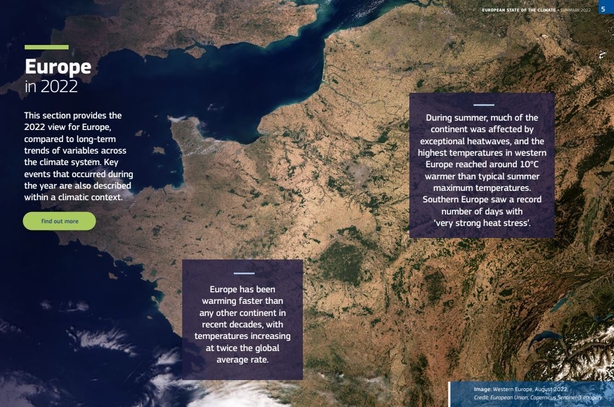Europe experienced its hottest ever summer last year, continuing a trend where the continent is heating up twice as fast as the global average.
A new report from the EU's Copernicus Climate Change Service (C3S) says that 2022 - at 0.9C above the historical average - was the second hottest year ever recorded in Europe and the summer - at 1.4C above average - was the warmest on record.
It says much of Europe was affected by exceptional heatwaves and, in western Europe, the highest temperatures were around 10C warmer than typical summer maximum temperatures.
The high temperatures and dry conditions contributed to the spread and intensification of wildfires, with the second largest burnt area on record.
In July, high temperatures and long sunshine hours meant surface ozone concentrations reached potentially harmful levels across much of Europe.
The exceptionally warm summer, following a winter with large snow deficits, led to a record loss of ice from glaciers in the Alps.
More than 5 billion cubic metres, or 5 cubic kilometres, of ice were lost from the Alpine glaciers last year, more than ever before in one year.
A significant and prolonged drought affected most of Europe in 2022, as lower rainfall in the spring continued into the summer.
The high summer temperatures contributed to the drought, and Copernicus says, the dry conditions may have contributed to the record surface temperatures.
Water flows In European rivers were below normal for 10 months of the year and at the second lowest level ever recorded.
In terms of the area affected, it was the driest year on record, with 63% of rivers seeing below-average flows.

The drought impacted natural systems and society and affected agriculture, energy and river transport.
The average Sea Surface Temperature (SST) across Europe's seas was also the warmest on record in 2022. In the Mediterranean, temperatures were much warmer than average for a prolonged period from May onwards, with record-breaking marine heatwaves during summer.
Record warm sea surface temperatures were also observed in the Bay of Biscay, English Channel and Irish Sea and in the Norwegian Sea.
In Greenland, a heatwave in September saw temperatures there 8C above the seasonal average.
There was exceptional heat and rainfall as a result of a series of atmospheric rivers, which are long bands of moisture transported in the atmosphere.
The frequency of atmospheric rivers reaching Greenland has increased since the late 1990s, contributing to increased melt of the ice sheet.
Three heatwaves and precipitation that fell as rain more often than as snow led to the most extensive September surface melting of the ice sheet on record, with at least 23% of its area impacted at the peak of the first heatwave.
Copernicus says on land, surface air temperatures have risen by 2.2C - much higher than the 1.2C global average.
It added that European seas, which have seen an increase of 1.1C, are also heating faster than the global average of 0.5C.








